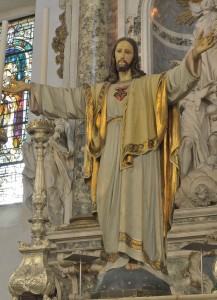Feeling hungry? How about a St. Honoré cake?
* * * * *
The St. Honoré cake is named for St. Honoré, the patron saint of bakers and pastry chefs. He lived in the sixth century and was the bishop of Amiens, in northern France.
Check it out:
This classic French dessert starts with a circle of puff pastry at its base, with a ring of pâte à choux (a light pastry dough) piped on the outer edge. After the base is baked, small cream puffs are dipped into caramelized sugar and attached, side by side, on top of the circle of the pâte à choux. This base is then traditionally filled with crème chiboust, a light pastry creme whipped with eggs. The whole creation is topped with whipped cream, using a special St. Honoré piping tip.
Who Was Saint Honoré?
Saint Honoré (also called Saint Honoratus, or sometimes Honorius) was the seventh bishop of Amiens, in the north of France, and died on May 16, 600 A.D.
He was so humble that when named to be bishop of Amiens, he resisted–feeling himself unworthy of the office.
According to legend, when news reached his hometown that he’d been proclaimed a bishop, his childhood nursemaid, who was baking bread for the family, refused to believe the news. She would only, she said, believe the news if the wooden shovel she’d been using to bake bread put down roots and grew into a tree. When the board was placed into the ground, it was transformed into a mulberry tree that produced flowers and fruit. A thousand years later, this miraculous tree was said to be still growing.
St. Honoré died in 600 A.D., and his body was exhumed in 1060. Following the exhumation, there were numerous reports of miracles attributed to him–such as a protection against drought. During one very dry season Bishop Guy, son of the Count of Amiens, ordered that a procession be held, and that the saint’s remains be carried around the walls of the city. Shortly after, the rain began to fall.
In 1202, a local baker by the name of Renold Theriens donated some land to the city of Paris, for the purpose of erecting a chapel in honor of the saint. The chapel became one of the wealthiest in Paris, and gave its name to Rue du Faubourg Saint-Honoré.
In 1400, the bakers of Paris established their guild in the church of Saint Honoratus, influencing more people to venerate the saint.
And in 1659, King Louis XIV officially established his feast on May 16, urging every baker to donate funds in honor of the saint and for the benefit of the community.
His statue stands in the portal of the Amiens Cathedral; and throughout the modern world, bakery shops and restaurants take his name.











